Combat Swimmers: Warriors of the Three Elements
The question is when a person first went under water for military purposes, and to this day remains open. But the modern military profession of combat swimmers arose at the end of the First World War.
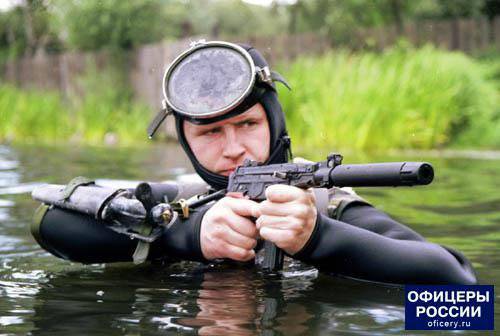
Connected by one axis
In the summer of 1918, Italian military engineers fleet On the basis of conventional torpedoes, a transporter was designed, designed for the covert delivery of saboteurs to the target. This primitive semi-submarine mini-boat was able to reach speeds of just a little over 2 knots (3,74 km / h). The car was driven by a crew of two people who were sitting on a dashboard on horseback, and their heads and shoulders protruded above the water when moving. Despite all the clumsiness of the apparatus from a technical point of view, in combat conditions the know-how has fully justified itself. On the night of November 1 to 2, two Italian officers quietly managed to get to the Austrian battleship Viribus Unitis and place mines with clockwork on the underwater side of the side. As a result of a powerful explosion, a warship with a displacement of 21 thousand tons sank.
With the coming to power of Mussolini in 1929, Italy began active preparations for a new war. Among other things, the British fleet dominating the Mediterranean was hindered by the Duce’s ambitious plans for the revival of the Roman Empire within the boundaries of the Octavian Augustus era. In order to effectively combat a stronger enemy, in March 1941 was formed the 10-I light flotilla MAS, underwater units led by the captain of the 2-rank of the Royal Italian Navy Prince Yunio Valerio Borghese, better known as the “black prince”.
Submarine units included a school for guided torpedoes, as well as a school of underwater saboteurs in San Leapoldo near Livorno. Here the cadets underwent thorough theoretical and practical training, learned to use oxygen devices, to make long-distance swims, to be under water for a long time, to overcome barriers and to install explosive devices. As a training, instructors liked to arrange two-kilometer marches along the seabed for the wards. The school of saboteurs was a closed world whose existence was kept in the strictest confidence. Volunteers wishing to become combat swimmers, underwent strict medical examinations and tests for psychological stability.
Prince Borghese's subordinates conducted their most successful operation in the winter of 1941 in Alexandria Harbor: six people, entering the strictly guarded port, blew up the British battleships Valiant and Queen Elizabeth, as well as sank the tanker. The battleships of the British were so severely damaged that in fact, before the surrender of Italy in September, 1943 never returned to service.
There were combat swimmers in the Third Reich. With non-standard ways of waging war at sea, the states of the fascist axis sought to at least somehow compensate for the frank weakness of their fleets. In March 1944, the command of the German Navy formed a subversive-assault compound "K" (short for the word "kleinkampfverband", literally - "combining a small battle"), which consisted of detachments of man-controlled torpedoes, exploding boats, single swimmers and submarines -mallies
The methods of combat training of submarine saboteurs in fascist Germany were, to put it mildly, very unusual. “Our group held the so-called“ small test of courage ”according to the method of Oplada,” the memoirs of one of the fighters of the compound said. - We, eight or ten people, were taken out into the open area and ordered to lie down on the ground with our heads to the center of an imaginary circle with a diameter of 4 m. Then a hand grenade was installed in the center, from which a safety check was pulled out. We counted seconds. There was an explosion, and the fragments flew over us. ” By the way, in the official curriculum such tricks were very prosaic name: the cultivation of personal initiative.
Connection "K" conducted a lot of successful operations, the most significant of which include the destruction of the lock in the port of Antwerp, the undermining of bridges across the rivers Orn and Waal in Holland and the Oder in East Germany. It was the Germans who first used light divers to carry out river sabotage, as well as the destruction of important military installations on the coast, which terribly annoyed the Soviet troops advancing towards Berlin. It is reliably known that two combat swimmers, remaining in the rear of the advancing Red Army and planning the next operation, learned about the defeat of Germany only on May 12! In April, 1945, even distraught with fear, rushing around in a bunker under the imperial office, Hitler requested, at his direct order, personal security from the soldiers of the “K” unit.
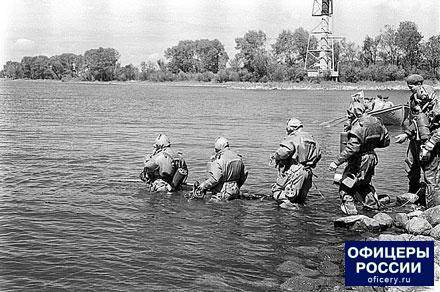
Roth goes under water
In the Soviet Union, the idea of creating reconnaissance divers was first expressed on the eve of the war with Finland. Already the first training of combat swimmers in October 1938 in the Pacific Fleet proved the right of this bold idea to exist. The saboteurs cut the anti-submarine network that defended the entrance to the bay, secretly stepped ashore, conducted demonstrative sabotage actions and returned to the submarine waiting for them.
A month after the start of World War II, in the last days of July 1941, the question arose of evacuating a diving school from Vyborg. Reporting to the command of the Navy about the current situation, Rear Admiral F. Krylov, head of a special purpose underwater operation expedition, expressed concern that valuable, well-trained diving personnel could be lost in the confusion. The admiral saw an exit in the creation of a special reconnaissance unit from among the cadets of the school, whose fighters, using light-diving equipment, would make raids to the rear of the enemy. On August 11, the People's Commissar of the Navy signed the order No. 72 on the formation of a staff of the special purpose company (RON) in the 146 staff at the intelligence department of the Red Banner Baltic Fleet. The place where the company was based was the island of Goloday. On the recommendation of Krylov, an experienced diver was appointed commander of the first part of the combat swimmers in our country. Mv Frunze, Lieutenant Ivan Prokhvatilov.
The basis of the tactics of the actions of his unit Prokvpilov laid ... lightning raids of the troops of Nestor Makhno, which the future officer witnessed when he was still in his childhood. “They flew to a village or a city, did their job and sunk into the water! Dissolved. They hid rifles and machine guns and turned into serviceable peasants. Look for them later! ”Wrote Prokhvadilov in his diary entries. The diving equipment, vehicles on water, walkie-talkies, and even small weapon pro-Quad members did, literally, from scrap materials.
According to veterans of the RON who survived to our day, there were no hopeless situations and impossible tasks for the pioneers of the Russian underwater special forces. During the war years they carried out a number of successful and unique operations of their kind. Prokhvakilov's subordinates threw grenades at the Italian speedboats from the legendary 10 MAS flotilla transferred to the area of Strelna, which were a great threat to our ships. Thanks to naval reconnaissance aircraft, launch pads for firing of blockade Leningrad with V-1 rockets, which the Germans were building near Luga, were discovered and destroyed from the air. In September, 1944 divers took part in a survey of the German U-250 submarine north-west of Ruonti Island. In addition to secret documents and an encryption machine, samples of Reich's secret weapon were raised from the bottom - torpedoes homing through the acoustic channel.
The bold raids of the Baltic on the enemy’s rear deserve a separate word. It is said that once a group of “Ronovtsev” dressed in German uniforms even helped the fascists to load a car with secret documents. Of course, one of the boxes scout divers took with them.
In the autumn of 1945, the command of the General Staff of the Navy decided to disband the company "as unnecessary in peacetime." For almost a decade, the unique experience of the RON was literally consigned to oblivion. Only by the end of 50-x new realities forced the military leadership of the country to recreate the special forces of the Navy.
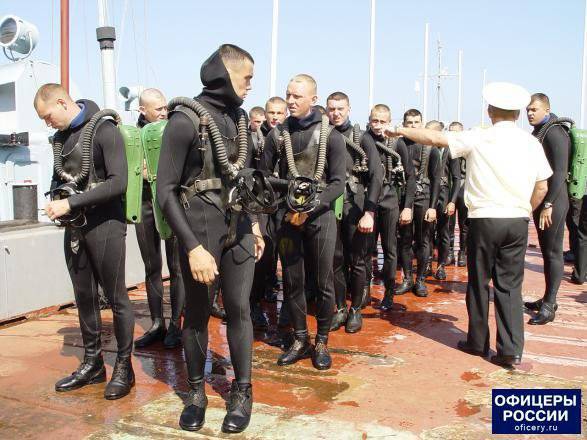
Swam, saw, won
In the post-war years, the Soviet naval special forces were faced with the following tasks: reconnaissance on coastal directions, destruction of mobile launchers, command posts, air defense systems, hydraulic structures and enemy ships. In parallel with these units, on each of the four fleets, there were so-called units of submarine anti-sabotage forces and equipment (PPSSS) created to protect our naval bases from enemy swimmers.
By the way, it was in the system of formations of PPDSS that special stations for animal training emerged. Dolphins, beluga whales, sea lions, were trained to look for various objects on the seabed, to conduct underwater surveys, to find and destroy enemy diving scouts. Finally, the animals themselves were used as underwater saboteurs: a mine was attached to their backs, which they were to deliver to the bottom of the ship or submarine and set in motion there, destroying the ship, and with it themselves.
The system of training special forces and anti-sabotage groups of the Navy was strikingly different from the methods used in other security agencies. It all began with a hard selection of candidates for the "amphibian people." For six months, conscripts who had the skills of scuba diving and sports discharges were trained according to a special program, where the physical and psychological loads were close to the limit. One such test was a night march without specifying the distance and run time.
After the transfer from the training to the combat unit, the “conscripts” began theoretical and practical exercises. The obligatory course included diving, airborne, navigational-topographical, mountain special, maritime, physical training, mine-blasting, hand-to-hand combat, survival in any conditions, study of foreign armies and theaters of military operations, radio equipment and so on. Since the specifics of the service provided for the conduct of combat, including under water, in addition to the usual small arms, the special forces had SPP-1 submarine pistols and no automatic counterparts APS.
Delivery of combat swimmers to the objects could be carried out by land, sea and air. Landing was carried out from very low altitudes, which significantly increased the risk. But the special forces sailors were not used to this. “The jumps were carried out without a spare parachute, since the time under the dome was still calculated in seconds. High preparedness allowed us to jump without injuries at wind speed 14 m / s, and at some exercises I had the opportunity to parachute at wind 17 m / s, ”recalls Alexei Budnev, a former naval special forces swimmer. An interesting fact: parachutist badges with the number of perfect jumps were forbidden for sailors to wear. And how then to hide the belonging of a fighter to a special naval intelligence service, if he has a chevron of diving service on his sleeve, and the “Parachutist-excellent student” badge is on his chest?
The versatility of the special forces of the Navy, its ability to perform tasks in any of the three elements was in demand. Combat swimmers guarded Soviet vessels during the youth festival in Cuba in 1978, accompanied by President of the USSR Gorbachev underwater escort during foreign visits to Reykjavik and Malta. For three days, 16 special forces, replacing each other, were on combat duty under water, with orders to shoot at any moving target within 200 radius from the protected object.
Swimmers had to solve not exactly “core” tasks, such as neutralization of unexploded ordnance, search in cooperation with the Ministry of Internal Affairs of dangerous criminals in mountainous and wooded areas, elimination of the consequences of man-made disasters. Several times a year, units of naval special forces were engaged to inspect military and civilian facilities inside the country: they “mined” strategic railroad bridges, secretly penetrated the territory of secret naval bases and nuclear power plants.
Alexey Budnev tells about one of these examinations for vigilance: “In July, 1986 was given us the task: to deceive the border guards and cross the sea cordon by entering the“ foreign vessel ”- the ship of intermediaries in 6 miles from the coast. They coped, although the city was full of alarm guards. In broad daylight, under the guise of having a rest, wearing “wet” diving equipment under clothing, saboteurs leaked one by one to the storming sea through “holes” in border secrets and patrols. The first 70 m passed under water, and then applied a special swimming technique without scuba gear. Hiding behind the crests of the waves, they passed the border boats and made another 10 km in the stormy sea. ”
The fighters of the “underwater front” also had more serious tasks. For six years, the military swimmers of the Soviet Navy served to guard the Dakhlak base in Ethiopia. They left the port surrounded by Eritrean troops on the last Soviet ship.
After the collapse of the Union, the most combat-ready part of the naval special forces remained under the banner of "independent" Ukraine. But the elite is the elite, to honor out of any situation. The special units existing today in the Russian Navy are in no way inferior to their Soviet predecessors, and even surpass them in certain matters.
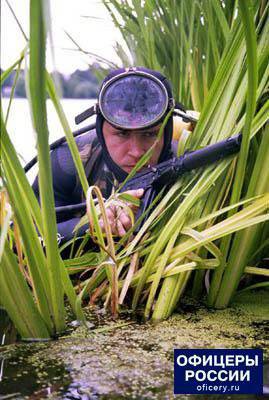
"Ihtiandry" of the special services
In other power departments of our country, own divisions of combat swimmers appeared a bit later than in the Ministry of Defense. Although story the training of such specialists in state security agencies began with a separate special-purpose brigade. Continuing the traditions of the first special KGB divers were employees of the Vympel group. In the hierarchy of the elite subdivision, these specialists occupied the top rung, since along with the training that was common to all of the Vampahelinists, they became qualified combat swimmers. The tasks confronting them were mainly of an intelligence nature. For example, working out channels for transferring illegal immigrants and special-purpose groups, working with coastal agents, setting up large-size caches. The main object, where the vamps, were trained several times a year, was the Poseidon base in the Caspian Sea.
Vladimir Butov, a former commander of the Vympel combat swimmers department, recalls that although his subordinates were in many ways inferior to the navy divers, some methods and techniques that corresponded to the specific tasks of illegal intelligence were nevertheless better mastered. For example, under the water, the pennants walked at a depth from 1 to 3 m. In this corridor, the greatest water turbulence and very low air flow. In addition, acoustic instruments and battle dolphins do not react to a moving reconnaissance aircraft. It is extremely difficult to sail in this mode, but this is aerobatics for a diver.
Swimmers from Vympel, together with colleagues from Alpha, and engaged in the protection of the top leadership of the USSR 9 KGB Directorate worked to ensure security from the sea state cottages Bocharov Ruchey, Foros, Riviera. “Once, together with Alpha, we conducted an“ attack ”on one of the state dachas. In the middle of a white day, nine people landed from a boat, reached the coast under water, carried out an act of terrorism against a conditionally protected person and left by sea. The operation took 40 seconds, and the guards reacted only after 1,5 minutes, when we had already sailed away, ”says Vladimir Butov.
The marine units existing in the structure of the Internal Troops of the Ministry of Internal Affairs also have detachments of divers of the anti-sabotage service. There are only two such unique parts in Russia. One of them is the Murmansk regiment guarding atomic icebreakers and the Atomflot repair and technology enterprise, which is engaged in recharging nuclear reactors, collecting and storing radioactive waste. The second is a separate battalion, whose fighters perform similar tasks in the Far East. In addition, individual companies and platoons are stationed in all industrial centers located near large bodies of water. There are combat swimmers in the structure of the Federal Guard Service. The duties of these past special officers include checking the Moscow River around the Kremlin, guarding the waters of all presidential residences.
Today, the number of “frog people” in the service in the central and territorial divisions of various law-enforcement agencies of Russia is approaching 2 thousand. A drop in the sea, given the total number of domestic "siloviki." And yet ... Many of the tasks solved by these people seem to be impossible. But the very fact that the enemy eliminates even the possibility of their fulfillment allows the combat swimmers to achieve success again and again.
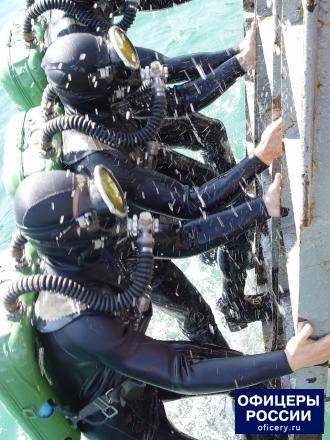
Our reference
Most historians believe that combat swimmers appeared simultaneously with the first sea battles that broke out between the Persians and the Greeks in 480 BC. According to Herodotus, Hellyne Skill and his daughter Gidna from Skion Island, whose inhabitants were known as skilled swimmers, dived to the enemy ships and cut the anchor ropes. The terrible storm that had happened at night smashed several dozen Persian warships against coastal cliffs. Thus, the feat of Skilla can be considered the first sabotage operation successfully carried out by combat swimmers in the history of mankind.
Especially effectively used divers in ancient Rome. There even existed a special unit (“urinatores”), whose tasks in addition to reconnaissance and sabotage in enemy ports included underwater inspection and repair of their own ships. Tactical methods of divers were also improved: the Romans allowed the enemy's vessels to the bottom, drilling holes in the sides with drills, imperceptibly for the sleeping team to tow them to their ports, take to the boarding, suddenly appearing directly from under the water.
During the battle for the Spanish fortress Andelis in 1203, Arab swimmers blew up one of its walls thanks to a barrel of gunpowder laid in the underwater part of the foundation. The Turks who besieged in 1565 the bastion of Knights and Ioanites in Malta also destroyed the coastal batteries of Christians with powder mines, which were installed by divers.
At the beginning of the 16th century, the brilliant Italian Leonardo da Vinci created a revolutionary breathing apparatus for his time based on compressed air cylinders and a prototype for a spacesuit to move at depth. The fact that the invention was intended solely for military needs, is eloquently illustrated by explanatory notes made by the engineer-scientist himself: “Fix the owners of the galley and the rest of the floods, and then fire the bombardment base ... It's all under water, the whole cycle”.
Information